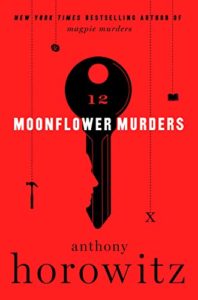This book will be published on November 10, 2020.
This is every bit as delicious a reading experience as Magpie Murders (2018). I really wasn’t sure how Horowitz was going to manage a second book, as several of the main characters in the first one are dead or heading that way at the end of the novel. But Anthony Horowitz is one of the smartest writers working right now, and this sequel to his (in my opinion) classic Magpie Murders is every bit as good as the first one.
The main character is editor Susan Ryeland, who has given up her successful career to head to Crete and help her partner run a small hotel there. It’s not going well. The hotel is having trouble and it’s a mountain of work, so when Pauline and Lawrence Treherne appear asking for Susan’s help in locating their missing daughter back in England, she readily agrees, especially when they sweeten the pot by offering her £10,000. She’s tired of Crete, she needs the money, and she takes the offer.
Why they offer Susan money is trickier – to explain, at any rate. Susan had been the editor of the hugely successful author, Alan Conway, whose creation, Atticus Pünd, sounds very much like Hercule Poirot. He’s intelligent and sees things others do not, and he always solves the crime. The Atticus Pünd books are set in the 50’s, but Susan and the late Alan Conway exist in the present. The Trehernes think Susan can find their daughter because, as Alan’s editor, she was most familiar with his work, and shortly before she disappeared, their daughter insisted that one of the Pünd books showed her the answer to a murder that took place in the hotel the Trehernes run, on their daughter’s wedding day, eight years ago.
Susan checks into beautiful Branlow Hall and begins to familiarize herself with the death of Frank Parrish, who was brutally killed with a hammer in room 12 almost a decade earlier. No one is pleased to see her except for the missing woman’s panicked husband, but none of the people she talks to can see how the case of Frank Parrish can be solved by reading a crime novel. True, the novel is also set in a hotel, one Alan Conway visited, and features a murder, but the similarities seem to end there. Or do they?
While Horowitz brilliantly sets up the mystery that Susan is investigating in the present, she finally must return to the book she edited all those years ago to see if she can discover what clue the missing woman found that seems to prove the accused killer is innocent. So, in the middle of what is actually a quite compelling story, Horowitz inserts the entire book – Atticus Pünd takes the Case – and dares the reader to solve the case along with Susan.
This is clever and could be heavy handed but it turns out that the novel within the novel is every bit as interesting as the central one, and I was quickly drawn into the second story. Sometimes it’s jarring when an author attempts something like this, but I was as easily transported by Atticus Pünd’s story as I was by Susan’s. Horowitz has kept the framework of the hotel for his second book but changed many of the details, while still including cruel and thinly veiled portrayals of the people Susan is investigating.
This novel within a novel is placed in the middle of the book, and the tone – before and after – changes as far as Susan is concerned. In the first part she’s unsettled and confused, in the second, her mind is clear and she becomes focused and sure. She does manage to solve both cases – that of the missing woman, and that of the eight year old murder. The clues are fiendishly clever and while I saw they were there as enumerated by Susan in her classical drawing room summing up with all suspects present, I didn’t see them as I inhaled each of the stories.
Throughout this updated version of a golden age novel there are clever nods to detective fiction, a genre Horowitz obviously loves and reveres. He has added to its luster with his contributions, both Susan Ryeland stories being, to me, instant classics. You’ll want to re-read this one.
